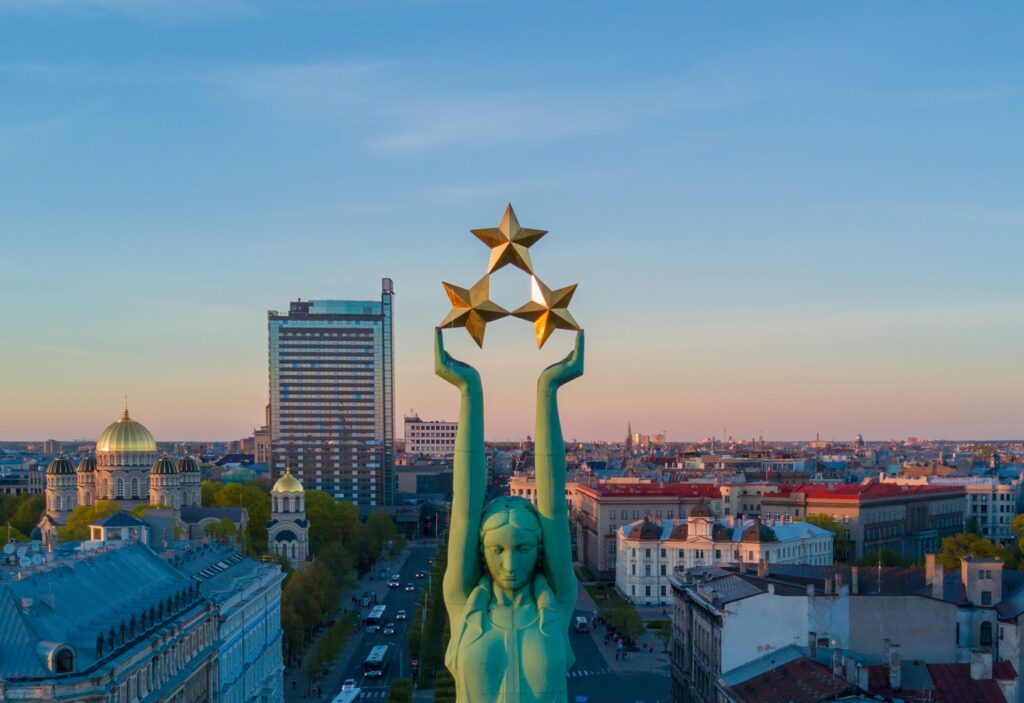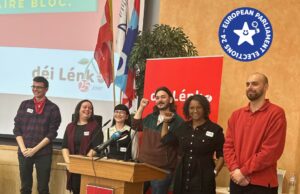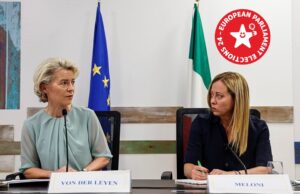In 2024, the Baltic states will continue to face the consequences of Russia’s war of aggression against Ukraine. The complex historical and political landscape, characterised by legacies of their Soviet past and the presence of Russian minority populations within their states, presents challenges for national self-determination and EU integration. In the midst of these tensions, Estonia, Latvia and Lithuania are forging their independent paths under the shadow of war which hangs over the region.
For the people of Estonia, Latvia and Lithuania, 2024 will continue to be dominated by the Russian war of aggression against neighbouring Ukraine. As neighbours directly bordering the giant aggressor country, they feel particularly threatened. Issues originating from their entangled histories play a role so significant only a few other member states of the European Union can compare. In the early 18th century, Estonians and Latvians came under Tsarist rule. Later, the Lithuanians were swallowed up in the midst of the tripartition of the Poland-Lithuanian Commonwealth at the end of the 18th century. With the exception of the years between 1918 and 1940, the three small nations on the eastern edge of the Baltic Sea have always been under the rule of St Petersburg and Moscow – that is until the collapse of the Soviet Union in 1990 and 1991 enabled them to seek their own paths to national self-determination.
Yet the return to the nation-state was tied to a special feature of their political demography that from the outset gave their bilateral relations with the new Russian state an idiosyncratic character. There remained after 1991 a substantial Russian minority population in all three countries, in large part as a result of Soviet population policy after 1945. This has brought with it domestic and foreign policy challenge for Estonia, Latvia and Lithuania for various reasons. As things stand today, just under 30 per cent of the total population in Latvia, over 20 per cent in Estonia and 5 per cent in Lithuania still consider themselves Russian. When Vladimir Putin gave his infamous speech to both chambers of the Russian parliament in March 2014 after the annexation of Crimea to justify its “return”, he emphasised that wherever Russians lived in significant numbers, the Russian reason of state (Staatsräson) was required to play a special role. While most observers thought of Ukraine, the people in Tallinn, Riga and Vilnius knew that the powerful Kremlin ruler was also specifically referring to their countries.
Taken together, the land-area of Estonia, Latvia and Lithuania make up an area about half the size of Germany. You can get a good idea of how sparsely populated the three Baltic Sea countries really are by considering this size against the population figures: only 6 million in total. These figures came into play during their deliberation on national independence. Since the 1990’s, the character of the independent nations of Estonia, Latvia and Lithuania has had a fixed course: integration into the West. At the time they regained their national independence, there was hardly any sensible alternative in terms of security policy, as the eastern military alliance of the Warsaw Treaty had quickly and unequivocally disintegrated after the failed coup in Moscow in August 1991.
This remains the case to this day – national independence for the Baltics is hardly conceivable without membership of the EU and NATO. Political vilification of Brussels for the EU’s role in undermining state sovereignty plays hardly any role in Baltic politics. Cases such as those of Viktor Orbán or Jarosław Kaczyński, who call for a national conservative revolution in the name of reclaiming sovereignty rights or demand a fundamental reorganisation of the EU into a mere economic community, are simply unthinkable on the eastern shores of the Baltic Sea. The greatest possible degree of economic and political integration within the framework of the EU is seen as the basic condition for maintaining their national existence under the prevailing conditions. The logical consequence of this orientation has been consistent and resolute support of further EU integration and NATO membership.
It may be an oversimplification, but it hits the nail on the head to say that Estonia, Latvia and Lithuania anticipated from the outset what the neighbouring countries of Sweden and Finland, which are much more economically developed, only felt compelled to admit after Moscow’s brutal actions against Ukraine – the necessity of NATO membership.
A small anecdote illustrates this point. In spring 2022, Vilnius City Hall was adorned with the Ukrainian national colours and a slogan in large letters that could be read in Lithuanian, Polish, Ukrainian and Belarusian: For your and our freedom! A passing observer finds himself in conversation with a Swedish tourist couple who have come over from Uppsala and is eventually asked to briefly translate what is written on the building. The reference to Ukraine’s defence against Russia’s invasion is obvious, but for the Swedes, there is no sense of deeper historical resonance. The famous slogan emerged after the national uprising in Poland in November 1830 against Russian rule was bloodily suppressed. The insurgents needed outside help, which no one was able to provide due to diplomatic constraints. Incidentally, during the next national uprising in Poland in 1863/64, Friedrich Engels and Karl Marx enthusiastically used this slogan! But back to Vilnius: the two Swedes certainly had much on their minds on this cold spring day, but one thing they were not thinking about was their country’s forthcoming accession to NATO, which is entirely in keeping with the logic of the slogan that was written in foreign languages on the town hall.
It must be noted here that robust nationality policy one of the important domestic and foreign policy factors in the EU’s modern policy landscape. Hungary’s Prime Minister Orbán should be mentioned here once again. Almost every year, he gives a speech in the middle of Romania – in a region that is significant for Hungarian history – that is coloured by the philosophy of history and from which the message is clear: Hungary is actually much larger territorially than the republic’s current boarders suggest. Without EU membership, this would be a ticking time-bomb for Hungary’s bilateral relations with its neighbours. However, any real threat it might represent is radically diminished by the knowledge that the EU offers suitable solutions to national minority issues, through its inseparable and integral rights for national minorities. Even the case of South Tyrol has long ago ceased to worry people on both sides of the border. In this respect, Orbán’s nationalist outbursts can – contrary to their wild claim – be regarded as a curious case of political folklore.
The same applies to the Russian minorities in Latvia and Estonia, although Lithuania is a different case due to its smaller population. When Putin repeatedly refers to the violation of minority rights of Russian’s abroad (i.e. in former Soviet republics) and says that Moscow is particularly challenged here, this applies much less to Ukraine and much more to the two EU members. The long history of this conflict will not be recounted here, but one fact cannot be denied. Under international law, what Moscow carried out by force (i.e. unilaterally) against both countries in 1940 and 1945 is considered annexation. Under international law, the annexing country is prohibited from exchanging populations, especially by violent means! In this respect, Riga and Tallinn insist on their right to compare the population composition in both countries in 1939 and 1990/91. And yet the question remains as to whether a consistent application and implementation of the EU’s customary protection of the rights of national minorities after 2004 would not have been the better approach. There are the bad experiences with regard to the strategic politicisation of minority populations in the lead up to the Second World War and in its aftermath. The German minorities in Czechoslovakia and Poland were instrumentalised and misused by Hitler’s Germany in preparation for its war of conquest. As the only solution after the war, the victorious powers decided that, by and large, German minorities would not be given a second chance; they would have to leave countries such as Czechoslovakia and Poland for good. However, after the collapse of the Soviet Union, there was no such question for the Russian minorities in the non-Russian former Soviet republics!
Since the early 1990s, mistakes have been made on the diplomatic stage on both sides – in Moscow as well as in Tallinn and Riga. The arising state of affairs has been cynically exploited by Putin in his dangerous rhetoric about a historic Russian claim to the Baltic states. And yet a détente on this flank between the EU and NATO on the one hand and Russia on the other seems inconceivable without raising the question of robust nationality rights.
Incidentally, Rosa Luxemburg provides a pointer: she always warned against violent, i.e. unilateral, border changes because they would lead to a major European war. However, she knew all too well about the patchwork of national borders in Europe at the time, which pushed her to become a staunch advocate for comprehensive and robust nationality rights within existing borders – the best example is her work The National Question and Autonomy, written in 1908/09.
Cover photo: Latvia, Riga, The Freedom Monument. By Ingus Kruklitis via Depositphotos.



